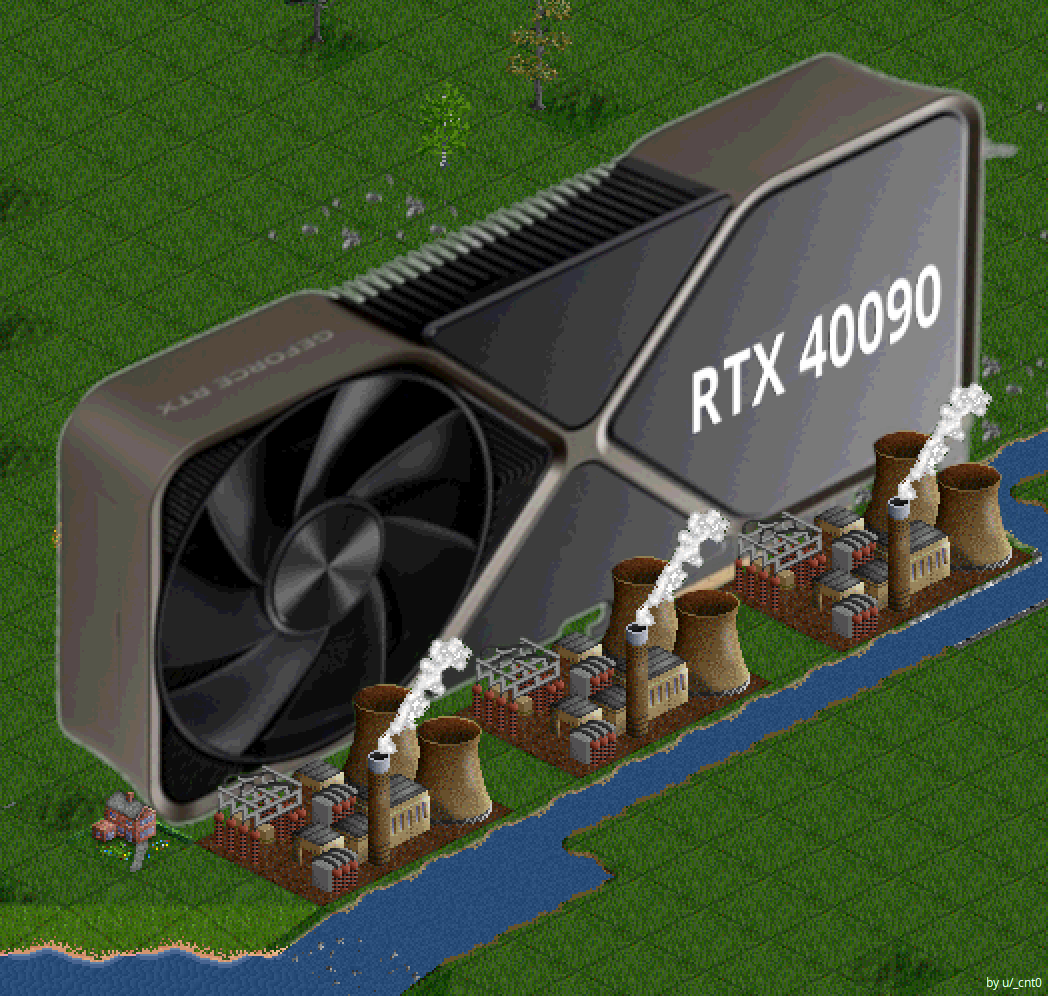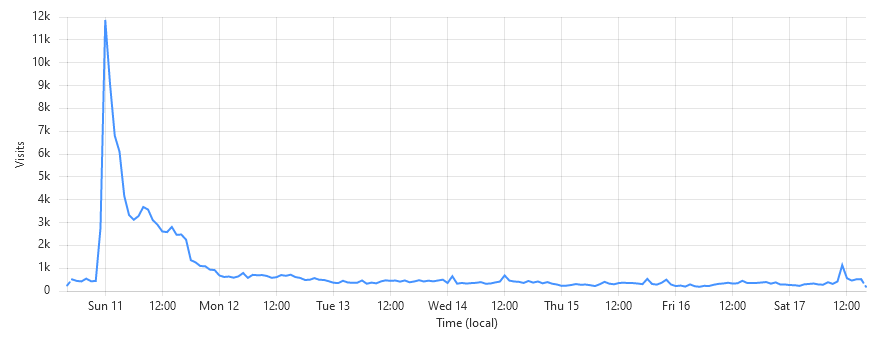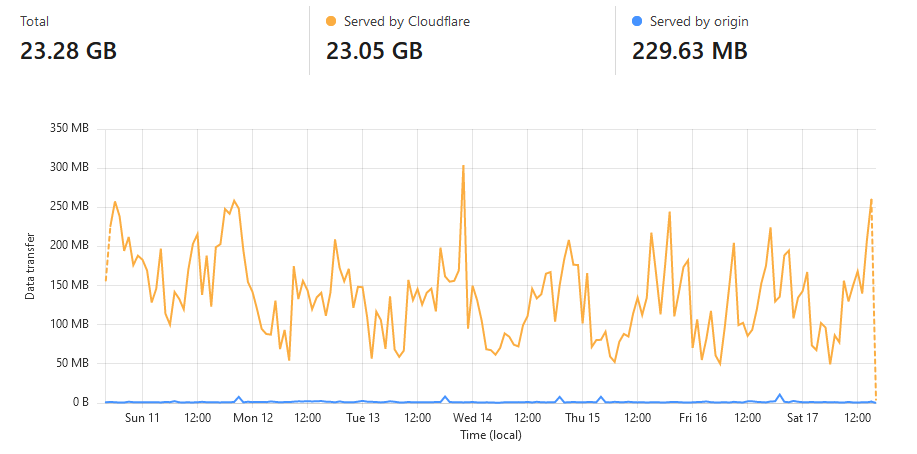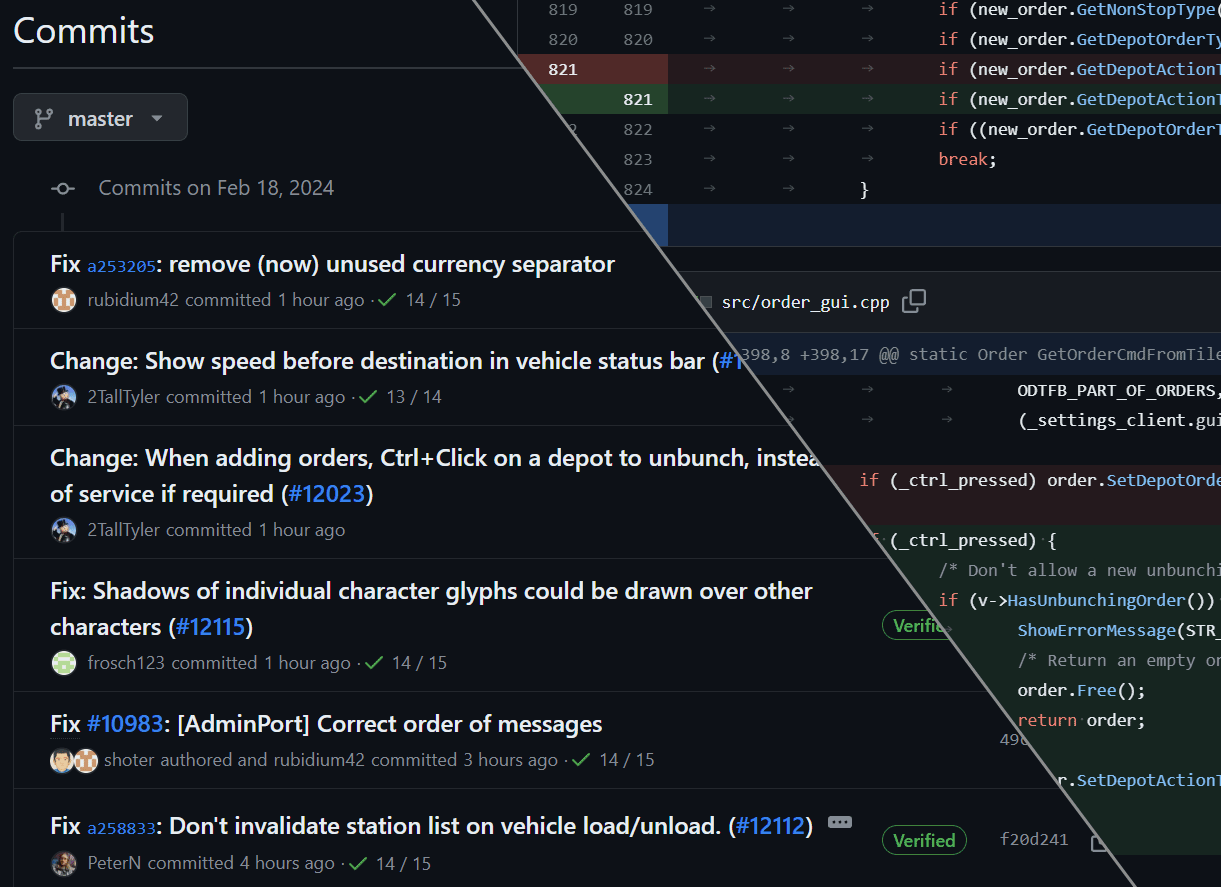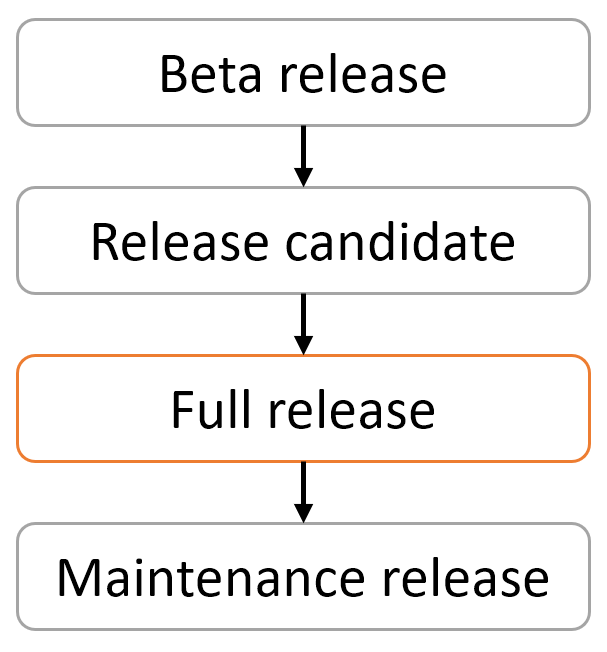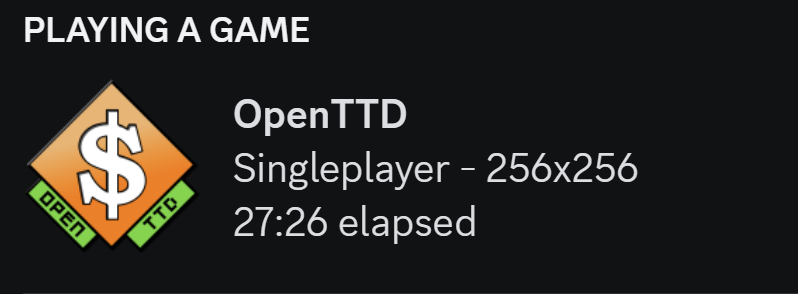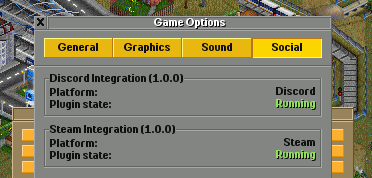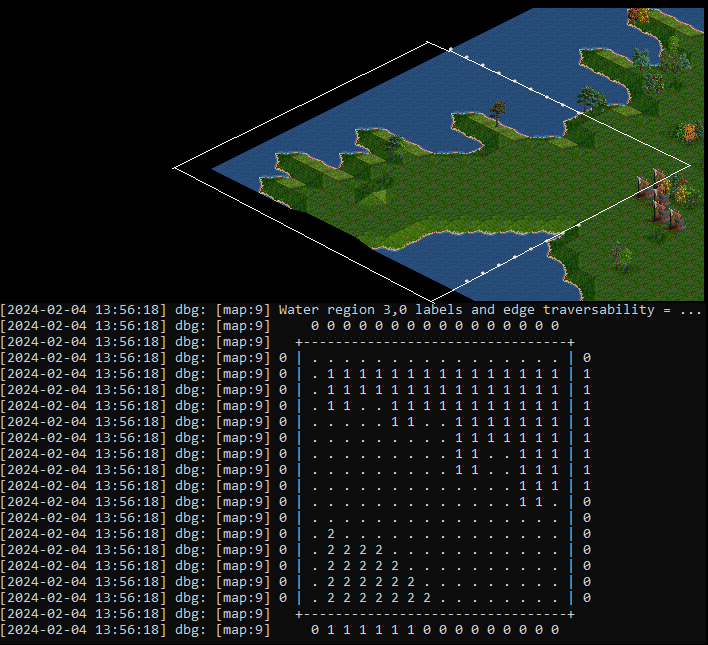Welcome to 14.0!
OpenTTD’s first release was in March of 2004. Now twenty years later, we are proud to present to you: release 14.0.
And boy, what a release it is. Do I dare to say: this has been the biggest release yet?
Sometimes people try to tell us OpenTTD is dead. Well, 14.0 shows you it really isn’t. There are so many new goodies in 14.0, that I don’t even know where to start! Let’s go over a few, just to get you a feel for what to expect when you launch OpenTTD 14.0.
Read more about our birthday celebration here.
When one day isn’t a day
It is now possible to make the calendar time walk slower, up to a point it is frozen. This doesn’t influence vehicle movement at all, nor the amount of goods transported, town growth, etc. But it does influence vehicle introduction dates, inflation, and aging.
With this feature, we hope to enable different game-plays, where people want to have more time to build out their empire before vehicles expire, inflation gets too big, etc.
A brand new day! For some a bit slower than others.
Read more about this new feature in the devblog.
Ship Pathfinder
The ship pathfinder got some great love. It is now capable of directing ships over vast distances without the need for buoys. In fact, one could say, you don’t need buoys anymore at all. The ships will still find their way!
Finally, no more “Ship is lost” non-sense. This enables ship-only games.
Read more about this new feature in the devblog.
Unbunching
Do you also hate when busses start hugging each other on a route? And you did your best to ensure you send them out the depot with a good distance between them. But something must have happened down the road, and now they are very close to each other!
Introducing: unbunching.
A new feature that allows you to tell all vehicles in a shared order pool to keep their distance; automatically, done for you.
Read more about this new feature in the devblog.
Social Platform integration
OpenTTD 14.0 allows better integration with Social Platforms. This is totally optional, and has to be installed separately. But once done, OpenTTD can talk to platforms like Steam, Discord and GOG Galaxy.
For now, the functionality is limited: friends can see you play OpenTTD, if you are in a server or not, and what kind of map you are playing. For future versions, we intend to expand on that, making more possible. But, small steps.
Read more about this new feature in the devblog.
Survey support
To finally put a rest to endless debates about what setting is used and which is not, OpenTTD now has an opt-in survey tool built-in. Over time this will allow us, developers, to better understand how OpenTTD is played, so we can better anticipate what will be a hit or a miss.
You can, at any time, opt in or out from the survey.
Read more about this new feature in the devblog
GUI improvements / scalable font
There has been a huge effort in making all our windows just a tiny bit better. Fixing pixel-errors, moving things around a bit, fixing colouring issues.
But .. not less important, we now also have a built-in scalable font! Zephyris created a real (TTF) font heavily inspired by the sprite font. This means that scaling looks a lot better, especially for zoom levels like 1.5x.
We love it so much, it is the default when you launch the game! (but no worries, you can revert to the sprite font if you really want to).
Read more about this new feature in the devblog.
New players experience
First of all, there is now a Help and Manuals button in-game, that helps you through the basic information of the game. Bringing information closer to the user, and the game more accessible to everyone, has been a path we have been on for a while.
Second, we revised a lot of settings, what their default value should be. Many settings have had their defaults changed, mostly towards enabling modern features by default.
Lastly, we also renamed Cheats to Sandbox. We noticed people were struggling with using “cheats”, as we have been conditioned that cheats in games are bad. But Cheats in OpenTTD context is much more “play how you like” (read: Sandbox). So we renamed it, hopefully making it more clear to new players that it is perfectly okay to use these Sandbox options any time they like.
Hopefully this helps new players get into the game easier.
So much more …
In total OpenTTD 14.0 comes with roughly 40 new features, over 500 bug-fixes, 200 changes, and many many code improvements.
It took us 2,000 commits to get from 13.4 to 14.0, we touched 140,000 lines of code and removed 74,000 of them. This was all done by over 60 contributors.
Interested how this all came together? Check out our blog post explaining it all.
A great thank you to all who contributed, with code or support; it is truly appreciated! Here’s to another twenty years of OpenTTD development!
I picked OpenTTD for the weekend and scoured BaNaNas and could not find the add-ons with the graphics that are being used in the banner of this community.
I managed to find some better 8pp trees, with "U&Trees" by Ufiby but I'd like to find those ground tiles and bridge graphics
Awnyone knows what's in use there?
Not a great screenshot, but it shows what can be done with a JGRPP eyecandy server. I'll try to do better in the future.
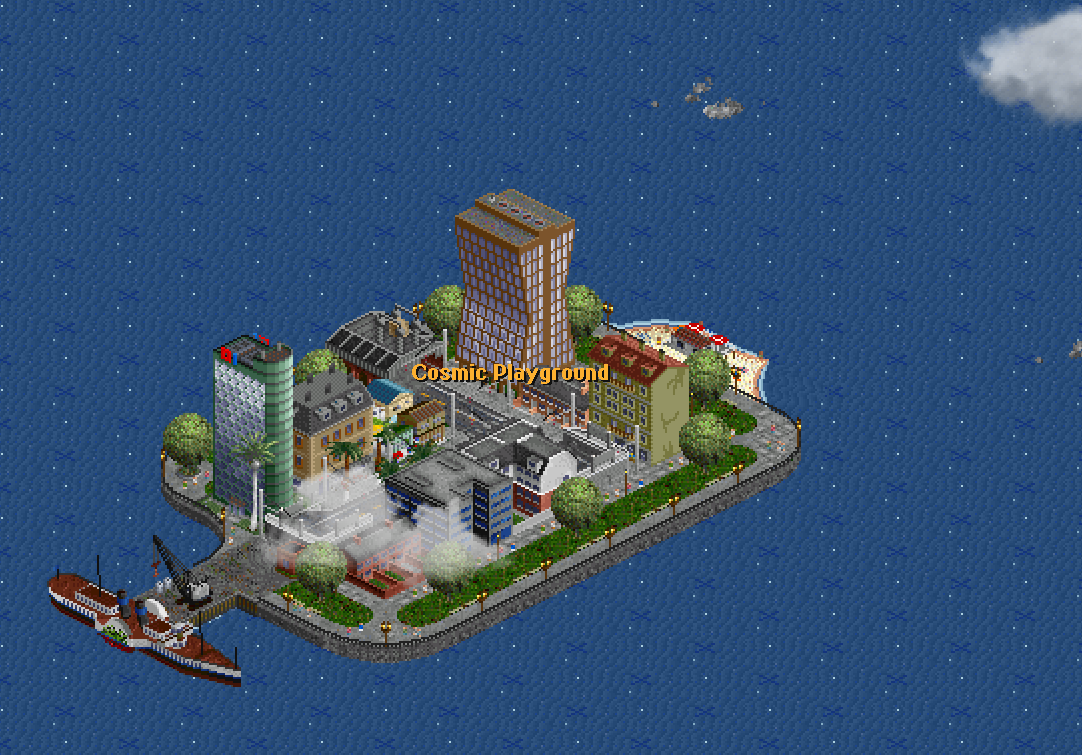
I was once the hottest new model on the street. Newspapers heralded my arrival in every town. The titans of industry were inspired to produce more goods when I visited their factories.
But as the years have passed, so do their eyes pass over me, to eye curiously my replacements. Will you try the new style, ma’am? It’s so much better than that old thing.
I’ve watched my friends grow old and die. My brother got caught in traffic and caused a horrific level crossing collision. I get sick more often, wheezing to a halt wherever I am. When I visit the doctor for a spot of renewal, they tell me, “Sorry, I can’t help. You’re too old.” When will I be autoreplaced?
Woe is the tale of the Balogh Goods Truck. But what if we could slow or pause the steady march of time? In OpenTTD 14, you can.
Time basics
Time in OpenTTD flows in three ways: The movement of vehicles, which we’ll call animation time. The keeping of economic records, including charging you running costs for vehicles, recording the graphs of your company’s income history, recording the production of industries and towns, and vehicle timetables. We’ll call this economy time. The passage of calendar time, affecting the introduction and expiry of vehicles, house styles, and the sub-arctic snowline (if using a variable snowline NewGRF). We’ll call this calendar time.
Let’s get the easiest out of the way first: we are leaving animation time alone.
Before OpenTTD 14, economy time was not tracked separately from calendar time. When players wanted to run steam engines for longer, they turned on “Vehicle never expire” or used the date cheat to rewind time when needed. Somebody wrote a Daylength patch, later included in JGR’s Patchpack, that slows down the combined calendar/economy time at the expense of many side effects.
But slowing the economy was not what old Balogh asked for.
The journey to real-time units
In late 2022, I began the work of splitting economy and calendar time. I was following a vision from my fellow developer nielsm, who proposed a novel solution to a problem that had vexed my previous attempts at this split.
The problem is this: If the economy does not follow the calendar, how do we display economy statistics like an industry’s “Production last month,” timetable arrival and departure dates, or the myriad other things that refer to time?
The ugliest solution is to display two dates. But OpenTTD’s user interface is confusing enough. Adding a second date is not a good user experience.
Nielsm’s proposal capitalizes on the fact that a day in OpenTTD is about two seconds, meaning that a 30-day month is about a minute. We can simply make this a bit more precise, then display economy time in real seconds and minutes!
The first step was making the seconds-per-day a bit more precise. The smallest unit of time in OpenTTD is a tick, of which there are 74 in a standard day. Prior to OpenTTD 14, one tick lasted 30 milliseconds, making a day 2.22 seconds. That’s close, but not quite close enough when multiplied out to a month or a year. But in TTD, one tick is 27 milliseconds, making a day 1.998 seconds. That’s about as perfect as we can get. In OpenTTD, we’ve gone back to this original TTD value to better align to real-time seconds.
With this the “amount of goods produced in an in-game month” is about the same as the “amount of goods produced in one realtime minute”. A “vehicle service interval of 100 in-game days” is about the same as a “vehicle service interval of 200 real-time seconds”.
Of course, not everyone will want to play OpenTTD using real-time units, so the new feature is an opt-in setting called Timekeeping units.
Calendar units are the classic OpenTTD experience, with no changes. Wallclock units use minutes anywhere months are normally displayed, with 12-minute periods substituting for years.
Where a date would normally be displayed (timetable start date, subsidy expiration date, etc.), the game shows an offset in seconds or minutes from the current moment. Timetables are expressed in seconds.
It’s also possible to select seconds as the timetable units in any timekeeping mode, in the Settings menu.
How to slow down time
There are two new settings used to control the flow of calendar time.
- Timekeeping: Select the timekeeping units of the game. Calendar is the traditional OpenTTD experience and you won’t notice any changes. Wallclock displays the new real-time units and is required to adjust the rate of calendar progression.
- Minutes per year: Select how long a year lasts. The default is 12 minutes. Set this to 0 to freeze calendar time completely. The maximum is 10,080 minutes, which is one week of real time!
The timekeeping mode can only be changed before starting a game, so choose wisely! Minutes per year can be changed at any time.
What about cargo scaling?
The economy time always progresses at the usual rate, so it has none of the side effects of the Daylength patch. That said, one of the side effects that players like is the reduced cargo production of houses and industries. We’ve added separate settings to scale these, and you can do this in any timekeeping mode.
You may notice some differences with NewGRF industries. Industries normally produce cargo every 256 ticks, and for base game and simple NewGRF industries we simply scale the amount of cargo produced. For NewGRF industries which calculate their own cargo consumption and production, this could produce unwanted results. For these, we instead scale the frequency of this production action, so at a lower scale the industry performs this action less often.
Some industry NewGRFs will have inaccurate helptext because of this change, as they will with wallclock timekeeping — for example, some industries increase production when supplied with boost cargos every three months. NewGRF authors will have to update their GRFs to display properly in the new modes, although of course there is no change required in Calendar timekeeping mode with 100% cargo scaling.
Cleaving time in two
Let’s get back to new time features. To actually implement these, we had to work backwards from the ending point. In order to stay compatible with calendar timekeeping units, the economy time units need to take the same form of years, months, and days, so that in calendar mode they follow the calendar date exactly. In wallclock mode, however, they diverge: an economy-month always has 30 days to always last one minute, so an economy-year always lasts 12 minutes. In contrast: the calendar-year lasts 365 or 366 days, so 12 minutes and 10 or 12 seconds.
This difference between calendar and economy dates is why players are not allowed to change timekeeping units in the middle of a game. OpenTTD’s 20-year-old codebase contains a lot of assumptions about how time works and does not react nicely to synchronizing or un-synchronizing two date systems. For example, if we are in calendar mode on the 31st day of the month and switch to wallclock mode, that day would not exist. The date would have to be shifted, but that can make company finance data stop being recorded for two thousand years, crash the game when the Cargo Distribution linkgraph checks if it’s time to update, or (worst of all) cause some other bug I haven’t discovered! Maybe someday, another contributor will write the code to nicely convert between the two modes and enable the timekeeping mode to be changed mid-game, but now is not that time nor am I that contributor.
Tech debt comes knocking
Of course, there was a lot of technical debt to be paid off before we could even get here. The calendar had to be cleaved in two and every reference to it evaluated to determine if it should continue to reference the calendar or be changed to the new economy timer.
My fellow developer TrueBrain was instrumental in helping me with this step, writing a new strongly-typed timer system to help catch any errors. Strongly-typed does not refer to how hard you bang the keyboard, but to a type of variable that refuses to accept the wrong type of data. So if I try to pass a calendar date to a variable that stores an economy date, the compiler will give me an error and refuse to compile until I fix it.
With a codebase as old as OpenTTD, anytime we touch something it provides an opportunity to leave the code better than we found it. With such a wide-ranging project as changing how time works, I touched most of the codebase and found many opportunities to refactor, fix, or clean up old code.
Conclusion
I have been working on this project for over a year, often putting in 20 hours a week. Like with most development, my motivation is a mix of wanting to play with this feature myself, and simply enjoying the challenge. Why optimize my rail network when I can optimize the code that makes it possible?
This is the last Dev Diary before we release OpenTTD 14.0. Thanks for joining us to learn more about the OpenTTD development process. If you’d like to learn more, we hope you’ll join us in the official OpenTTD Discord or on GitHub. Stay tuned for a release post around April 1st!
With OpenTTD 14, we introduce an opt-in survey system; a method where we can finally ground our debates with facts! Additionally, BaNaNaS content will use HTTPS (instead of HTTP), and many more small infra-related changes.
Time to chat about this for a bit.
Survey
For years now, we can have very passionate discussions about one gameplay style or the other. And often, sooner or later, someone will drop the “that is how 90% of players play” argument in there.
Do they have anything to back up that 90%? Of course not. It is an emotional argument in an often emotional discussion (as we all greatly care about the game). But it doesn’t actually help the discussion further, as the other party goes: “no! That is how only 10% plays!”. And as such, the discussion dies off and we are unable to move forward.
To finally settle which 90% was correct, OpenTTD 14.0 introduces an opt-in survey system where, after every game, a report is sent about the settings used in that game. This is enabled in the 14.0 betas and is already giving very solid insights how the game is actually played; instead of how we all think it is. It is extremely valuable for further development, to better balance where to put focus.
It is extremely important to us that this survey mechanism is both transparent and privacy friendly. As such, a lot of effort has gone into ensuring it is both.
When you first start OpenTTD 14, you are greeted by a dialog asking you if you want to opt-in to the survey. If you don’t (either close the dialog or decline), no survey information will ever be sent to us. But if you do, at the end of every game, a small file is transmitted to us.
What is in it you ask? For that we created a “Preview” button, which shows exactly what information would be sent. Nothing more, nothing less. What is in there, is what we receive.
And if you change your mind (or want to see the Preview again), under “Game Options” you can change your choice at any time. No strings attached; no nag-screens “are you sure?!”. We highly appreciate it if you enable it. But if you don’t, that is perfectly fine too.
Once received, the survey is processed and checked whether it is a valid survey, for what version, and stored in an efficient way in the backend. Every once in a while an analyzer runs over all the surveys to produce survey results. They can be seen here with all their details made available.
There are all kinds of protection against over-representing one population or the other, although we still have work to do to tune that system better. But, as more surveys arrive, we also have more information to improve on this.
So if you are curious how your playstyle is versus many other people: check out the summaries and get an impression!
Just be warned, and I have to remind people about this almost daily: the summaries are a snapshot of that moment in time and can over-represent one group or the other. Until the actual 14.0 is released, be aware that the sample size is rather small and summaries can differ widely from week to week. In other words: be careful to not make wrong conclusions on something, based on a result of a single week.
Popularity
Often it is rumoured that OpenTTD is dead. We don’t see any evidence of that, however you slice it.
OpenTTD development is doing very well, as the new feature list for 14.0 is showing. But also: the player-base has not declined.
Take for example the amount of concurrent players on Steam. In the last 3 years this amount has grown, from ~600 to ~1000. That is a huge increase.
From internal Steam financial information (yes, free games also have financial information), we can see that the game has been installed by almost 2 million unique users in the last 3 years. That is so many more players than I ever expected would play this game.
More information from Steam: we can also see how popular our news posts are. Our 13.0 release post, for example, has been read by 150,000 unique players (with over 2.5M impressions). That is a lot; especially for a free game that is 20 years old!
When we look at our wiki, we see that weekly ~100,000 unique players visit the wiki for one page or the other. Most popular is, of course, the tutorial section on the wiki.
And although normally we get around 100 unique visitors per hour on our main website, sometimes there are posts like this on popular websites. These posts increase that number to over 12,000 unique visitors in just an hour.
All in all, OpenTTD has been as popular as it has ever been and many players still play the game day to day. In fact, we see a (slow) increase in popularity, especially when looking at bandwidth usage. More on this in a bit.
BaNaNaS via HTTPS
When BaNaNaS was added back in OpenTTD 0.7, it was done via a custom TCP protocol. Very quickly we found out that it was bandwidth hungry and we needed a good way to distribute this load.
HTTP was added in OpenTTD 1.0 for this goal and most downloads you do today are actually done via HTTP. But, as HTTP is less and less common these days, and more and more companies start to block communication over HTTP, it was time to implement HTTPS.
Where our HTTP downloader was a custom build, with all problems that come with it, for HTTPS we use either WinHttp (Windows) or libcurl (Linux / MacOS). This means that someone else took care of all the complexity of downloads via HTTPS and we have a simple interface to download a file.
With this change we hope many more people can download BaNaNaS content via HTTPS (instead of TCP); this is not only a lot quicker (as HTTPS uses Cloudflare, which ensures downloads come from a local Point of Presence (POP)), it is also a lot cheaper for us if you do.
BaNaNaS bandwidth bill
Hooking in to the above, the move to HTTPS also has another goal: about 10% of our bandwidth for BaNaNaS is till this day done via TCP. Although the HTTP(S) downloads are free of charge (thanks to Cloudflare), the TCP downloads are not.
To be more exact, as they are served by AWS, it costs 0.90 dollar per GB transferred. And this grows to a large number very quickly; over 50% of our monthly bill is only for BaNaNaS downloads traffic.
Now there are many ways to mitigate this, ranging from “migrate away from AWS” to “just disable TCP downloads”. But for now, I have good hope that the change to HTTPS will move even more traffic away from TCP. Related to that, we also removed the setting that forced usage of TCP over HTTPS: OpenTTD now always tries HTTPS first; and only if that fails, it falls back to TCP. Hopefully that sufficiently reduces the bandwidth bill.
If not, we will need to take action on this. I keep hoping Cloudflare releases the ability to route TCP (and not just HTTP(S)) via their infrastructure; they keep teasing this in their blog-posts, but they have since 2021. So at a certain point I have to give up that hope and find a better solution myself.
Infrastructure
Our migration in 2023 was a great success and continues to be so. Deployments have never been easier and maintenance has been a breeze. Auto-healing and incident resolving work as expected and in general, Nomad has been a good fit. This combined with our new GitHub workflows, there is a clear noticeable difference in how much time is required to keep everything running (for the better, ofc).
Our Cloudflare bill has been very stable; which is very good for a project like OpenTTD, as predictability means we can try new things, and see their impact.
For example, this year we added a Symbols server. This server collects all the debug-files for all our OSes, making it easier/faster for us to delve into crash dumps people send us. Before the Symbols server there were a lot of manual actions required to open up a crash dump; now it is just pressing a single button and waiting for a bit.
We also added much more caching to the wiki. As wiki pages do not change all that often, we can cache them pretty aggressively. This means that if you go to our wiki now, Cloudflare serves almost every page from cache. In the background it does validate if any content is out-of-date. If any out-of-date content is found, the cache is updated with the latest. For you this means a much faster website; for us it means a lower AWS bandwidth bill. Around 5% lower, in case you are curious.
Lastly, a bunch of backend services gained a Prometheus metrics endpoint, meaning they are easier to monitor, what they are up to, and how they are used. This for example allows us to see how many (percentage-wise) OpenTTD players have an IPv6 enabled connection (answer: 23%) and what versions of OpenTTD are connecting to BaNaNaS. This helps us understand where to put effort for the backend services and what is “working as expected”.
Donations
As you might know, the OpenTTD infrastructure is fully paid by donations. And for years now, we didn’t need to do a fundraiser, as you all graciously donate enough money in a year to pay the bills. What helped, especially in the earlier years, that we were often sponsored by companies with infrastructure related sponsorships.
These days we enjoy fewer sponsorships. This is not always a bad thing; if you are a paying customer, companies are more likely to help you out. Especially with infrastructure this hasn’t always been the case during sponsorships.
That said, two companies do deserve a shout-out, as they do sponsor us still and we greatly appreciate them.
Pulimi, to help manage our infrastructure. 1Password, to ensure we can store all OpenTTD related passwords safely.
We told them by email, but also here: thank you so much for your on-going sponsorship; it is truly appreciated.
As for the rest of our infrastructure, we are on our own and the reserve we had is slowly running dry. This means it is not unlikely we will once again need a fundraiser sooner or later. When that moment arrives, we will let you know. Till then, I would like to thank you all for your donations; we really do appreciate them and they keep the (virtual) lights on.
Future ahead
As for the future, there is a lot of interest for Cloud Saves: something we are still looking into. With Cloud Saves you would be able to save your savegame in the cloud and continue playing it from where-ever you are. And as with all services OpenTTD offers, it will not be only available for Steam players, but for everyone (regardless of what platform you use).
The main trouble here is to figure out what the cost per player will be and making sure we can actually afford it year-to-year. As you can read above, although we are financially healthy, we have to ensure we stay that way. Which means it will mostly depend on whether the changes in 14.0 help in reducing the BaNaNaS bandwidth bill, before we start extending our services to include new (not-cost-free) services.
The biggest concern we current have: how big will the average savegame be? Do most players play small maps? Or very large maps? This is not an easy answer, but will be answered by the survey results.
To give you a rough estimate: the cost for Cloud Saves will be roughly 0.02 dollar per GB per month stored. If we assume an average savegame to be ~10MB and we allow storing 10 saves per player, that would mean the average player will cost us 0.002 dollar per month. Or 0.02 dollar per year per player. On its own not a lot, but if you remember from earlier: we have ~1000 active players per day … it could add up to a lot of money really fast. So we need better metrics to know how many players to expect. And whether ~10MB is fair.
As you can read, lots to do here before we can even start to think about the technical implementation. These things just don’t come for free!
More about OpenTTD 14
This post is part of the series of dev diaries about big new features coming in OpenTTD 14. Next week, we will experience some time dilation, and dive into one of the biggest new features in 14: timekeeping!
Ever wondered how a new OpenTTD release is made? How we decide what features to include and what to reject or how some people seem to know the “future” before you? Curious what it means that OpenTTD is Open Source? Or maybe you’ve even wondered what it takes to get your idea included in OpenTTD?
In this post, you’ll get a peek behind the quite transparent curtain and learn more on how OpenTTD is developed.
What’s source anyway?
Let’s start with the meaning of Open Source, as the source (or source code) of a computer program really is the source of it all. In a nutshell, the source code of a computer program is a form that is a lot easier for humans to understand than the instructions the computer is executing. For OpenTTD, we use the programming language C++. This source code is then transformed by a piece of software called a compiler into a binary form that the processor in your device can run. The binary is then combined with various other data files to create the game you can download from our website or for example get via Steam.
While every computer program has a source, not every program is Open Source. Open Source requires that the source code is freely available and allows modifications by other parties. You can look at the source code of OpenTTD right now in our git repository on GitHub ~(but please come back here afterwards)~. To be able to track changes to the source code, we use a version control system called git. It shows us each and every individual change (called commit in git) that was made to the game since its inception 20 years ago. Being able to see old changes is quite useful when trying to fix problems or figuring out why something was done the way it was done. The list of commits is also what you need to watch to gain “magical” knowledge about things that are coming in future releases of OpenTTD.
Our GitHub page is also where things are tracked that are not yet part of the game and still in development. You might have encountered it before as the place where you can report an issue with the game. Besides the git repository of the game itself, GitHub also hosts various other git repositories related to the game, like for example OpenGFX, NewGRF development tools or various back-end infrastructure.
How a feature is born
Now that we know where development happens, let’s look at how it happens.
Each and every change to OpenTTD, no matter if it is a large new feature or just a simple one-line bug fix, starts with someone choosing to spend their time on it. As the source code of the game is freely accessible, this can be literally anyone, for a multitude of reasons.
Many features come about because someone has an idea how their game could be better and decides to work on it. Bugs are usually fixed because someone either feels responsible for it in some way or is just plain annoyed by it. But really, everybody has a different personal motivation. There’s one reason you’re not going to find though: Because the boss said so, or because it is on the big company road map. OpenTTD is purely developed by volunteers, there’s no company, foundation, or other controlling central entity behind it.
Ideas are often discussed in the development channel of the official OpenTTD Discord. It’s a good way to gauge interest, exchange ideas and chat about issues before spending any significant time on something. It’s also a fast way to get help or inspiration when stuck on something while developing for OpenTTD. While activity in the channel does vary over the day, someone is usually always awake.
Now let’s assume that the person is in fact developing a feature (like for example the new ship pathfinder) and has completed the initial development. Since OpenTTD moved to its current home on GitHub almost 6 years ago, we’ve adopted a fixed process for any change to OpenTTD. The first step in the process is to open what is called a pull request (PR) on GitHub with the proposed changes to the source code in the form of git commits. Additionally, we require a description of the changes following a specific template to make sure nothing important is left out.
Whenever a PR is opened, various automatic checks run to verify some formal things, but while those checks are running, other contributors can already begin to review and comment on the pull request. The automated checks include what is called continuous integration (CI), which ensures the PR actually compiles on all platforms we support and not just the one the author is working on.
Automated checks are well and good, but so far they can’t replace a human code review. In code review, other people look at the code and try to find any issues or spots that could be improved. This can be everything from validating functionality, checking UI and user experience, to proof-reading code comments. For a large change like the ship pathfinder, we even organized a multi-player test game to check for any dreaded desync problems.
Usually, this results in a back and forth between the author updating the PR and the reviewers looking again until the PR is either declared good or rejected. Unfortunately, not every author has the motivation to follow this until the end, so it happens that PRs just kind of fizzle off without reaching a finished state. Up to here, everybody can pitch in with reviewing a PR, but actually approving or rejecting a PR requires a decision by someone that has commit access to the OpenTTD repository.
PR aren’t actually outright rejected that often. Reasons for rejection might be that the PR is contrary to the goals of the OpenTTD project, like trying to add content that could be very well done as an add-on NewGRF. Sometimes it also happens that a PR is meant well, but just not the right solution for a particular issue because it might affect some other part of the game negatively.
For approving a PR we’re quite strict, maybe stricter than many other projects out there. The OpenTTD project has a rigid code formatting style guide and commit message format. We’re also unlikely to accept a PR with known problems or unfinished parts. For example, the game is translated to many languages, including some that are written right-to-left, and any UI code needs to be coded to work for all languages and not just English. Finally, GitHub will prevent approving a PR if any of the CI checks have failed.
While all this might sometimes appear to be overly pedantic and petty, a strict quality control is important to make sure the game can continue for the next 20 years. Everybody has probably noticed that everything, from your desk to the storage shelf in the shed, seems to always descend into chaos unless cleaned up regularly, and code is no exception to this. If we wouldn’t care about code quality, the source code would probably be a hot mess after 20 years and full of bugs, making any new features really difficult.
One thing of note here is that no author can self-approve a PR, even if they have commit access to OpenTTD. In this sense, all PR authors are treated equal and need to follow the same process to get a PR approved.
Finally, if a PR has the coveted approval, it can be merged into the main code base. This can be done by the person approving it, but especially for bigger changes we like the merge to be done by a second set of eyes. From that point in time it is part of the game, but not yet in the version you are playing right now. For this it still needs a release, which we’ll cover in the next section.
###The release process
There are two kinds of releases we make for OpenTTD. The first one is the “nightly”. This is automatically made out of a snapshot of the source code each day. The nightly release uses almost the same CI workflow as described for the PR checks, except that the result is published on our website and on Steam.
The other kind of releases are the interesting ones, the ones that get a proper version assigned, like the upcoming OpenTTD 14.0. These happen whenever we think there are enough new things, improvements, and bug fixes since we made the last major release.
If you’ve been following the news on OpenTTD, you’ll have noticed that we’ve already released some versions with a 14 in it, but yet we’re telling you that 14.0 will come soon. You might ask: What’s up with that? Unfortunately, programmers are just as human as you are, and thus it is very likely that OpenTTD contains numerous bugs at any given time.
To make sure we can give you the best possible game to play, all major releases follow a specific path, which is shown in the image on the right. It starts with one or more so-called beta releases. A beta release is taken directly from the main source code at a certain point in time. The main purpose of beta releases is to gather feedback from players about new features and to find any issues with the game. Beta releases are still marked as testing releases and are usually not included in Linux distributions or the normal Steam updates, thus depend on players willingly trying a potentially unstable game version.
Even if it’s directly taken from the main source, there’s still a lot of stuff that needs to be done even for a beta release. Someone has to look over all the changes since the last release and write the changelog. The website news post has to be written, posts for social media like Discord or Reddit prepared, and an image for the Steam news post drawn. When everything is ready, a so-called tag is created that marks a specific commit. With this tag, some more automated CI workflows compile binaries for the various platforms we support and upload them to our website and the other distribution platforms. When the CI is done, the news post can be published and the social media posts made so you will actually know that there is a new release.
As it is rare to not find any issues, there are usually multiple beta releases until the number of issues encountered by players drops sufficiently. The next major step in the release process after the betas is branching and feature freeze. Branching means that the source code for the release is split off from the main source code and will no longer automatically track changes made there. Bug fixes are still applied to the branched code, but new features are not. This helps to prevent last-minute problems in the release versions.
After branching, the testing releases continue with one or more Release Candidates (RCs). RCs are similar to the beta version in that issues are still expected, but as no new features are applied anymore, the issue count should go down, not up. The actual release is basically done the same way as a beta: prepare a changelog, all the social news, make a tag, wait for the CI, and finally tell the world.
When no more major issues are found in the latest RC, the time for the first proper release has come. There’s really not much difference in the release process from the RCs, except that this version is not marked as a testing release and thus will be for example picked up by the automatic update on Steam or GOG. We do spend more time on the changelog, news post and social media posts for the release, as a proper non-testing release has a much larger audience than the preceding testing releases.
Inevitably, a larger audience is also better in finding bugs, which is why the maintenance releases exists. Maintenance releases are the X.1, X.2 and so on versions. They do not include new features over the major X.0 release, but fix whatever issues are found.
Thanks to a lot of behind the scenes magic done by some wizards on the CI workflows, the most time-consuming part of any release is actually creating and publishing all the public-facing text and information. Compiling the binary and uploading the result to the various distribution platforms requires surprisingly few mouse clicks to trigger. This wasn’t always the case though. When OpenTTD was still young and sites like GitHub were just not a thing, the various binaries for e.g. Windows, Linux or macOS were hand-compiled by different people, manually collected and uploaded. Often enough that meant that it literally took several days until a release could be downloaded for all platforms. Compared to that, the current automatic CI workflows really do feel like awesome magic.
Getting personal
If you’ve been diligently reading till now, you might have noticed that I haven’t used the word “developer” so far. Instead, I’ve mostly talked about a generic someone. So what’s up with that?
While many people think that the individuals with merge permissions are “the” developers of OpenTTD, this isn’t really true at all. GitHub provides various statistics for each project, and lists 169 contributors to OpenTTD at the time of writing this. And this number is still much too low, as it is for example missing many contributors from before we were on GitHub, and doesn’t count our language translators since their changes are committed by a bot. These hundreds of individuals are the real developers of OpenTTD and the people with commit access are more akin to housekeeping or maintenance.
When you read something like “Why haven’t the devs included X yet?”, it is very rarely because someone with merge permissions said “nope”, even if the questions is often phrased to imply this. It is not included yet because nobody volunteered their time for it.
And that really is the gist of it. OpenTTD is not backed by a big company or some other institution, but purely by volunteer work. OpenTTD depends on donations. This does include monetary donations needed to pay for infrastructure and services, like our website and all the automated systems we’ve described here. But probably even more important, it also includes time donations. And time is what is missing most of time (ahem). So the best way to get X included is to donate some of your time.
Final thoughts
OpenTTD would not have made to 20 years if it weren’t for the hundreds of people that chose to donate some of their time to the project. As such, we are very thankful for everybody who contributed something, no matter how small or big. Without people who contribute code, triage issues on GitHub, make translations, create content like NewGRFs or AIs, or help answer questions on places like the official Discord, Reddit, or Steam forums, OpenTTD would not be where it is right now. And without you playing the game, it wouldn’t be here either.
More about OpenTTD 14
This post is part of the series of dev diaries about big new features coming in OpenTTD 14. Next week, we’ll get a survey of some more behind-the-scenes work that helps us to better understand what players like about OpenTTD.
If you don’t know me, I’m Owen Rudge, and have been involved in the online Transport Tycoon community for almost 25 years. Exactly 21 years ago, I received an ICQ message (look it up, kids) out of the blue from a guy named Ludvig Strigeus (nicknamed Ludde). “Hello, you probably don’t know me, but I’ve been working on a project to clone TTD for a while.” he said, more or less. He didn’t want to release this to the public yet, and wasn’t entirely sure what he was going to do with it. (He’d been working on it since 30th June 2002, so I guess that is technically the birthday of what would become OpenTTD…) Ludde sent me a copy of what he’d been working on, and it was very exciting indeed. It was a fully functional version of Transport Tycoon Deluxe, written in C. Admittedly incomplete at that time, it was still quite remarkable.
To put things in context, in 2004, the Transport Tycoon community generally enjoyed playing the classic Transport Tycoon Deluxe with the excellent TTDPatch started by Josef Drexler. The original Transport Tycoon games only ran on DOS and Windows 95/98, and TTDPatch allowed us to play on the then-current Windows XP, while adding a huge number of exciting features, such as the ability to use third-party graphics and vehicle sets. TTDPatch was an amazing piece of software, but there were always some fundamental limitations - the map size couldn’t be changed, extra cargo types couldn’t be added, multiplayer was difficult to improve, and so on. So having an almost fully-functional clone of TTD, written in a high-level programming language, suddenly appear out of nowhere got people very excited indeed.
Ludde made more progress with the project over the coming year, and it looks like we even attempted some multiplayer games (not too reliable, especially over my dial-up connection at the time). Eventually, when he was happy with what he had created, he agreed to allow me to release the game as open source. Coincidentally, this happened exactly a year after I’d first spoken to him, on the 6th March 2004. But first, it needed a name. I don’t think I thought very much about it, but decided that “OpenTTD” had a nice ring to it, so registered a SourceForge project, created an OpenTTD forum on TT-Forums, and set it loose. OpenTTD 0.1 was released. You can still download it if you want to see what it was like, though it’s not particularly straightforward to run!
Things really got going after this, and a community started to form with enthusiastic developers fixing bugs, adding in new features, and smoothing off the rough edges. Ludde was, I think, a bit taken aback by how popular it proved, and even rejoined the development effort for a while. A read through the old changelogs reveals just how many features were added over a very short period of time. Quick wins like higher vehicle limits came in very quickly, and support for TTDPatch’s NewGRF format started to be functional just four months later. Large maps, improved multiplayer, better pathfinders, improved TTDPatch compatibility, and of course, ports to a great many different operating systems, such as Mac OS X, BeOS, MorphOS and OS/2. It was a very exciting time to be a TTD fan!
Within six years, ambitious projects to create free replacements for the original TTD graphics, sounds and music sets were complete, and OpenTTD finally had its 1.0 release. And while we may not have the same frantic addition of new features we had in 2004, there have still been massive improvements to the code, with plenty of exciting new features over the years, with major releases every year since 2008. The move to GitHub in 2018 and the release of OpenTTD on Steam in 2021 have also re-energised development efforts, with thousands of people now enjoying playing the game regularly. And development shows no signs of slowing down, with the upcoming OpenTTD 14.0 release including over 40 new features!
When I released Ludde’s work back in 2004, I don’t think I could have anticipated where OpenTTD would be ten years later, let alone twenty. Personally, I would like to say thank you to everyone who has supported OpenTTD development over the past two decades - first to Ludde, who has gone on to be an incredibly successful and influential developer. Of course, there have been many developers who have contributed so much over the years, plus the graphics artists and other content developers who have created a wealth of wonderful add-ons for the game. I’d like to also thank everyone who has donated money to cover server costs, and indeed the dedicated folk who maintain that infrastructure (especially TrueBrain, without whom the OpenTTD project in its current form probably wouldn’t exist). We must also show our appreciation for Chris Sawyer for the amazing game that inspired OpenTTD in the first place. Finally, of course, I’d like to thank you, the players! None of us would be here if people weren’t still playing the game.
Seeing how the first twenty years have gone, I can’t wait to see what the next twenty years have in store. :)
This station worked fine, until I added the last train stop on the bottom. Now the trains will not use the first three stations, only the bottom one. Any idea why?

Always wanted to know what kind of OpenTTD game your friends are playing on Steam, Discord or GOG Galaxy? You finally can!
In OpenTTD 14.0, we ship a plugin system which allows OpenTTD to integrate with platforms like Steam, Discord, GOG Galaxy, etc. This didn’t come easy, and is the work of many years figuring out what the best approach would be.
When we first released on Steam back in 2021, it became clear that we would love to integrate with Steam. Only two months after our release on Steam, we started to figure out how to make this happen. In that same month a first draft was created … and it took until now to make that a reality.
We have been asked many times over these three years why we didn’t integrate with Steam yet; why it is taking this long. So in this blog post, we will shed some light on what was needed for this to happen. Answering the question: why does it take so long?
Let’s delve in!
Licensing
The first hurdle we had to take wasn’t technical at all: how do we deal with all the different licenses involved with integration on these platforms.
As you might know, OpenTTD is released under GPLv2. This is a good license for an Open Source game, as it ensures that everyone who makes a modification to the game also have to release the source for that modification. And, if we would like to, we can integrate that change back into the vanilla game again, allowing everyone to enjoy that modification.
There is one downside of the GPLv2 license: it is not really compatible with many other licenses, as it is kinda strict in the implications. I am not going to delve too much into the details in this post, but just know once something is GPLv2, everything it touches has to be GPLv2 or compatible with it.
To integrate with social platforms like Steam, Discord, etc, you have to make use of an SDK they supply. As you might have guessed by now, they are not licensed under a so-called “free” license, which conflicts with our GPLv2 license.
Besides the legal part of the license, we also have the social part of “how people feel about it”, if we would integrate such non-free SDKs directly into the game. And this has always been a debate.
As it goes in the world of Open Source Software, people tend to have a very strong opinion about the “free” part of the license. And so integrating with something non-free is against the principles, and as such, by their argument, bad. We can’t simply dismiss such arguments because we want to integrate with social platforms.
Which means we needed to find a balance: make sure OpenTTD as a game remains Open Source, free, and GPLv2 licensed. But also allow integration with social platforms.
The solution, as it turns out? Make it a choice.
Plugin system
To ensure the game itself remains licensed under GPLv2, we created a simple plugin system which allows us to extend the game with other binaries which might be licensed differently. We have been doing this for years and years now, via our BaNaNaS system. This delivers in-game content to the user, while the author of such content can license it how ever they like. The only “demand” we make, is that the author gives us the right to distribute their content, and that it is available free of charge.
In result, we see a wide variety of content on BaNaNaS, under all kinds of licenses. Some authors embrace the ideology of OpenTTD, and use open or free licenses. Others are more protective of their work, and do not allow anyone to make derivatives of their work. From our point of view, we don’t actually mind either way: as long as our players can download it for free and enjoy the content, we are more than happy and grateful for your efforts.
The plugin system that is added to 14.0 uses the same logic and mechanism. Although technically it is very different, more on that later, but from your point of view it is the same: download a plugin, put it in the right folder, and enjoy the added functionality.
Currently we are releasing three plugins: Steam, Discord, and GOG Galaxy. The source of those plugins are released under MIT licenses; another Open Source license, with much simpler conditions compared to GPLv2.
Security is a thing
Content uploaded to BaNaNaS is executed in the game via sandboxes: nobody can read files on your computer, make network connections, or anything like that. They can only do things we allow the addons to do, which is a very restrictive set of actions.
This is a lot harder for a plugin system that integrates with platforms like Steam, Discord, GOG Galaxy, etc. We can’t sandbox those really, as they have to be native binaries (executables) that run on the player’s system.
So, we have a dilemma: if we would allow a plugin system in the same way we allow BaNaNaS content, anyone could upload a plugin for anyone to download. And that plugin could, in theory, contain things that are harmful to the player. For example, a bitcoin miner or something silly.
This meant we had to find a balance between allowing such plugins and not allowing anyone to just provide any plugin. What we came up with, is a system where a plugin can only be loaded into OpenTTD, if we, the OpenTTD Development Team, approved the plugin.
We find this less than ideal, as we like that BaNaNaS allows anyone to come up with ideas, try them out, see what people think. But, we also have to keep the security of players in mind. And there is just too much potential for harm when we would open up the plugin system to anyone. As such, we were left with no other choice than to restrict who can make those plugins; or of course, not do it at all (which is even less ideal).
In result, every plugin is released and signed by OpenTTD, and before loaded into the game, it is validated the signature is correct. If you are a developer and want to design your own plugin, please come talk to us. We are not against new and different plugins; but we have a responsibility to the players to ensure it doesn’t compromise their security.
Capabilities
With the licensing and security finally addressed, and a solid idea how to build the plugin system, we started work. But as you can imagine, it was a lot of work, with a lot of moving parts. Like … seriously, it took many hours figuring all this out, and getting it right.
An additional challenge was that we release for three OSes: Windows, Linux and MacOS. And they all deal with plugins in a slightly different way; enough to be challenging. A lot of testing, failing, trying again went into getting this right.
Complicating the situation further: we don’t have an active MacOS developer, nor do we have access to a physical Mac. This meant we had to proxy the development / testing via other people who do have a Mac. The conversation went like: “does this work?”, “and now?”, “what does it say?”, “no, in that other window”. I mostly want to thank Emperor Jake for helping out here. Your patience to test yet-another-MacOS-test-build is greatly appreciated.
All this also meant we had to make a choice: either get something to work now and build on it later, or try to do everything at once, potentially never finishing it at all. We went for the first approach, but it also means the current capabilities of the plugin system are rather limited. So don’t think too much of it yet.
The main thing it currently does is announce you are playing the game, whether you are in the Main Menu or in-game, and what kind of map-size you are playing. Other things like being able to join each others games etc is all not implemented yet, but hopefully someone will pick that up for the next version. But, as always, no promises!
How does it work?
When you first start OpenTTD 14, a new folder “social_integration” will be created in your OpenTTD documents folder. In here plugins can be installed, for example the Steam plugin. You have to extract its content in this “social_integration” folder, and start the game.
When the game starts, it is validated that the plugins are signed off by OpenTTD, and if they are, they are loaded. The first step for the plugin is to check whether the social platform is running. If so, it starts the integration with that platform. A plugin can only integrate with a platform that is running when OpenTTD starts; so make sure Steam, Discord, and/or GOG Galaxy is already running before you start OpenTTD.
Under “Game Options” -> “Social”, you will find whether the integration is running.
For Steam, we automatically add the Steam and Discord plugins. For people downloading the game manually, they have to download the plugins manually as well. This is explained on the download page.
The future
With the biggest hurdles out of the way, the future is bright. We now finally have the ability to extend OpenTTD in a way that doesn’t violate our license or the spirit of the license, while still integrating with non-free platforms. And that in a secure way.
This means that for next versions we can start looking into other parts of these platforms, like making use of their network capabilities (joining people’s games, but also maybe making use of Steam’s relay network), or possibly even achievements. We also really would like to deliver these plugins via BaNaNaS, so updating is a lot easier (currently you have to manually download them from our website).
All this will not happen overnight, and maybe not even in a few years. But instead of having to deal with all the above things, developers can now focus on that what is actually interesting: the plugins themselves. Of course this requires people working on this, so if you like a challenge and want to help out: please drop by! Any help is greatly appreciated.
Personally, I am mostly looking forward for the ability to just join someone’s game by right clicking on the friends list and clicking Join Game. A lot of things have to be created to make this possible. For example, when you are currently in a Single Player game, nobody can join. But in a modern game this is a very outdated concept; better would be that when someone wants to join a Single Player game, it automatically upgrades to a Multiplayer game and allows your friend to join. And of course we need to ask you if you are okay with your friend joining. As you can imagine, a lot of work is required to make this happen. But I think it will be awesome when it does!
In closing
I hope by now you understand that integration with social platforms was not only a technical challenge. We also had to deal with both the legal side of licensing, and with the spirit of our license. Additionally, finding a way to keep things secure yet configurable wasn’t easy either.
In total it took over 3 years of figuring out how we want to do it. And over 3 months of actual work to program it all and ensure everyone was okay with this implementation.
It was a journey, one could say. But finally we are here. And I can’t wait for the next step!
More about OpenTTD 14
This post is part of the series of dev diaries about big new features coming in OpenTTD 14. Next week, we’ll talk about how OpenTTD 14 came into existence, and how you can be part of it. Till then!
OpenTTD 14.0 comes with a new ship pathfinder which allows ships to travel great distances without the use of buoys. Gone are the days of long strings of buoys and convoluted ship orders. Using ships is now as hassle-free as the other modes of transport. Just add the destination and send the ship on its way!
In this post, I’m going to explain how the new pathfinder works and some of the challenges we had to overcome.
Motivation
Personally, I was never satisfied with the way ships worked. All other vehicle types “just work” and always find their path, but ships needed buoys to get to their destination. Placing buoys at the right interval is guesswork at best, and having to add them all to the order (and in the right order) is a pain. In my opinion, it simply makes ships no fun to use. I often found myself terraforming narrow stretches of land into the ocean in order to create railways to access oilfields. Yes, I am “that guy”.
Having messed around quite a bit with A* pathfinders and derivatives, I always felt there had to be a better way to achieve this. I played around with several ideas, but most of them didn’t scale well and didn’t make it off the drawing board. Getting things to work smoothly and reliably on a 4096x4096 map turns out to be quite a challenge. But as they say, “if it was easy, it would have been done already”.
Why is it so difficult?
So why is it so hard for ships to find a path? If trains can do it, so should ships, right? The main problem is that open water creates a ton of symmetric paths which are all “equally good”. The pathfinder must explore all of these permutations in order to find the best path.
Trains don’t have this issue because they are restricted by tracks and junctions. Potential paths branch off far less often, even in complicated networks. The same is true for road vehicles and trams. For ships however, the amount of path options grows exponentially as the distance increases.
The pathfinder eventually hits the node limit and has to throw in the towel. Raising the node limit gets you a bit further, but the impact on game speed becomes more noticable. Adding more ships further exacerbates the problem, since having twice the number of ships means twice the number of pathfinder calls. And since larger maps often means more players and large travel distances, one can see that the problem only gets worse as the scale increases.
The solution
The solution I went for is a two-tiered pathfinding system, somewhat similar to the well-documented HPA* algorithm. First, we try to find a coarse, high-level path. If such a path is found, we choose an intermediate destination not too far from the ship. We use the low-level pathfinder to plan a path to that intermediate destination. Once we reach it, we run the high-level pathfinder again, and the process repeats.
Think of it like taking a long trip with the car: instead of planning the entire journey in meticulous detail, you just focus on how to get to the next city. Ironically, this is similar to how buoys work: they also provide a sequence of intermediate destinations. But this time it requires no user effort.
To enable the high-level path search, we divide the map into 16x16 tile regions. Within each region, we identify separate patches of water. Each tile gets a label, and all tiles with the same label belong to the same patch; i.e. they are interconnected. We also identify whether a ship can travel across a region edge into any adjacent regions. Aqueducts crossing into other regions are also taken into account. The region abstractions allow us to search the map incredibly fast, hopping from region to region instead of from tile to tile. We are effectively searching the map at a “lower resolution”, ignoring the details at the tile level.
Keeping regions updated after construction and terraforming requires some effort, but the impact on overall performance is minor. Such changes invalidate the region, which means it has to be updated the next time the pathfinder “bumps into it”. This can be done quickly, and the big benefit of this approach is that once the region is updated, its data can be used for subsequent pathfinder runs without any additional effort (until the region gets invalidated again).
Suboptimal paths
Searching at a lower resolution unfortunately means that the path is not guaranteed to be the best path. Locally the path to the intermediate destination is optimal, but globally there might exist a path that is shorter. This is the tradeoff between speed and optimality that we have to make. Luckily it is not so bad to have a slightly suboptimal path. Getting a “good enough” path very quickly is much more preferable, especially when dealing many ships traveling great distances. And that trail of buoys you made before probably wasn’t entirely optimal either :). The pathfinder has been tweaked to produce good paths, and you will probably only find signs of suboptimality if you really look for it.
In closing
For me personally, the difference is night and day. I generally avoided using ships, and I know many other players did too. Now I love using them. They are a fun mode of transport, and I hope to see more users give them a second chance now that they work well right out of the box.
So go ahead, create a giant map and let ships travel from one side to the other. No buoys needed!
P.S. Buoys aren’t going to be removed. You can still use them as waypoints.
P.P.S. We have also added support for faster ships and faster ship acceleration in NewGRFs, for an even more complete ship experience.
More about OpenTTD 14
This post is part of the series of dev diaries about big new features coming in OpenTTD 14. Next week, we’ll delve into the integration with Steam, Discord and GOG Galaxy. From now on, your friends will be able to see how much you love playing this game!
A repost of his screenshot from before the Speztruction of r/OpenTTD.
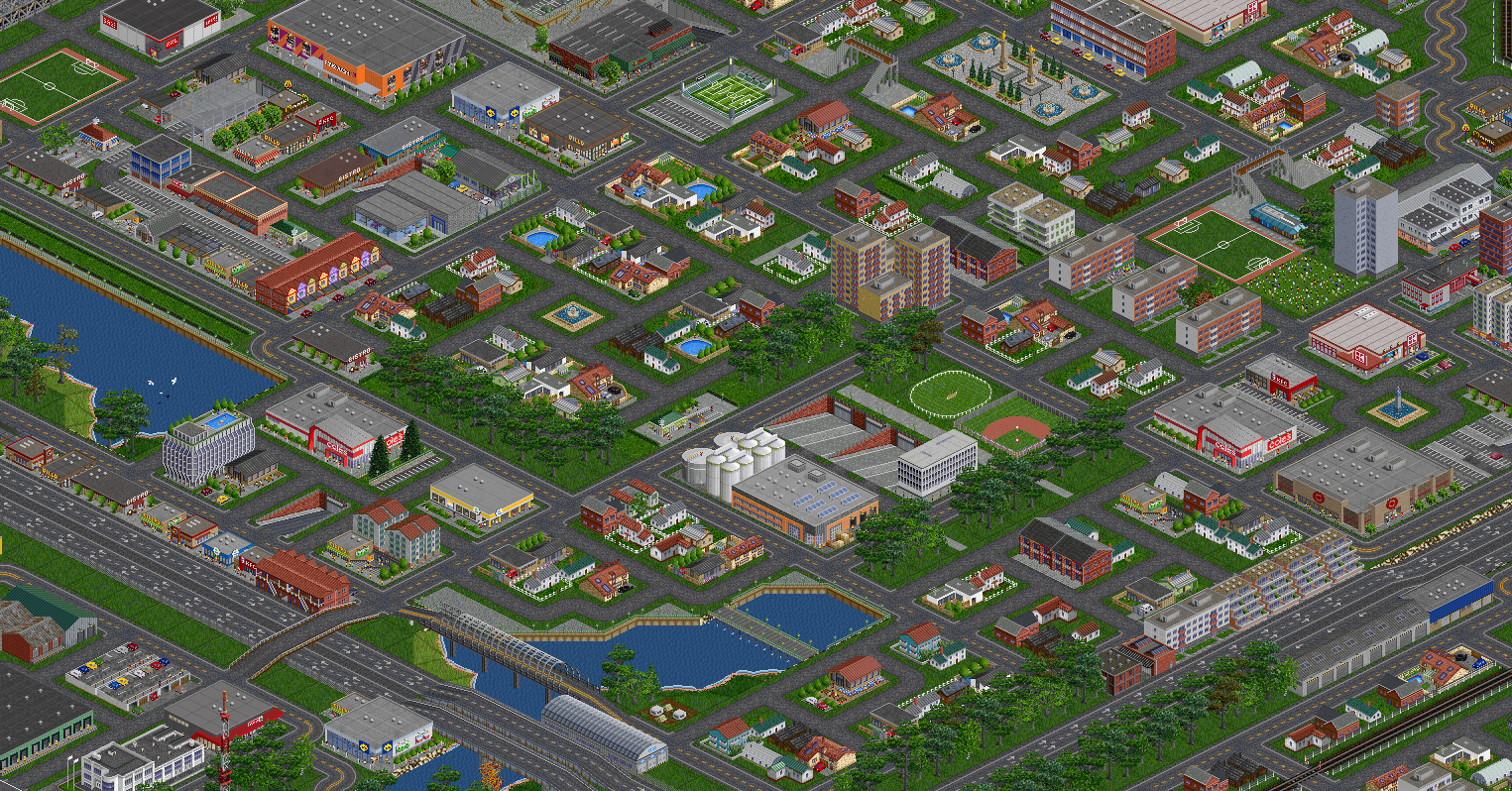
A repost of his screenshot from before the Speztruction of r/OpenTTD.
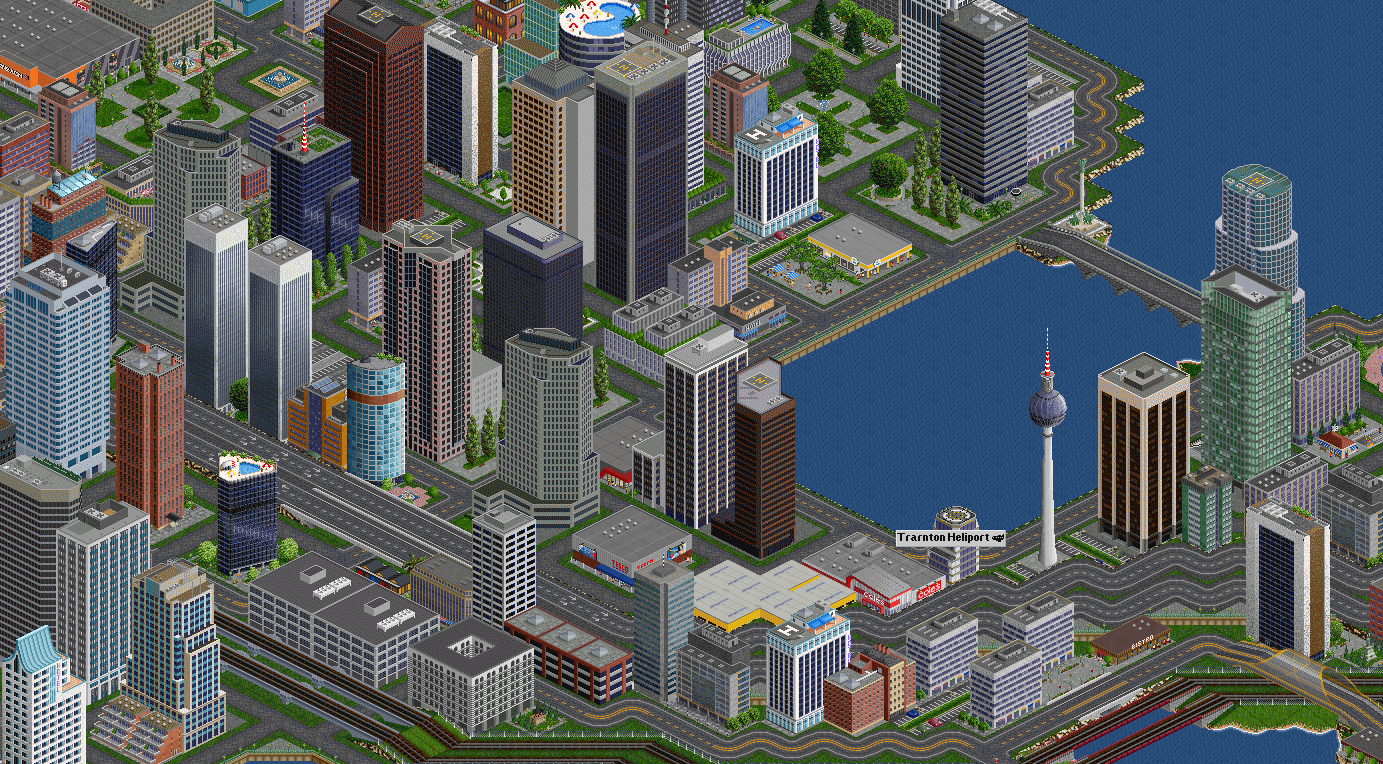
cross-posted from: https://lemmy.zip/post/1600385
I’m on endeavourOS and can’t get the game to run. I downloaded it and installed via GOG but it doesn’t work. When I look in the AUR I can find the game engine and another app for it but I’m not sure if it’s the actual game that I can install and run.
Can anyone help me with this?
(Crossposted from https://sh.itjust.works/post/9890238 because its two months old. I don't plan on crossposting anything else from other OpenTTD FediVerse communities until some new content has been given time to be viewed by the original poster.)

(Crossposted from https://sh.itjust.works/post/8044109 because it's no longer new; don't worry, I don't plan to snatch credit for anything.)
cross-posted from: https://lemmy.zip/post/4737235
Taken directly from OpenTTD's official website.
If you see a GRF you recognize, post the name of it!
Identified GRFs
- FIRS Industry Replacement Set
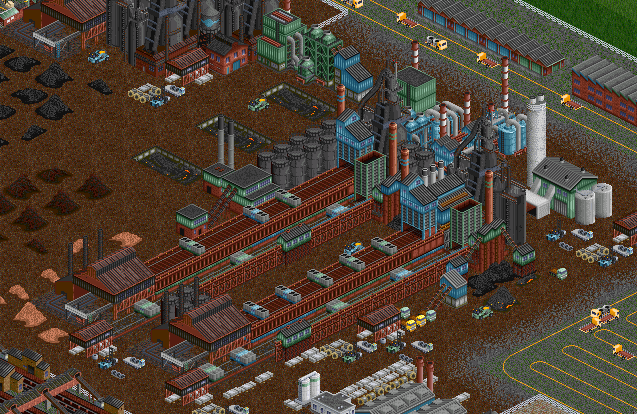
I think the one mod that I relied on added more signals on the bridge length, so multiple trains could go on the bridge at the same time.
Can't remember the others, but I remember thinking some functions should be part of the base game.
This version of c/openttd must follow the rules of sh.itjust.works, so please keep that in mind. Other than that, the mod's only job is to protect this community from spam and trolls; we are not your lawyers, we will not protect your meaningless licenses for a free and open source video game, so if you don't want something to be "stolen", don't post it on the internet.
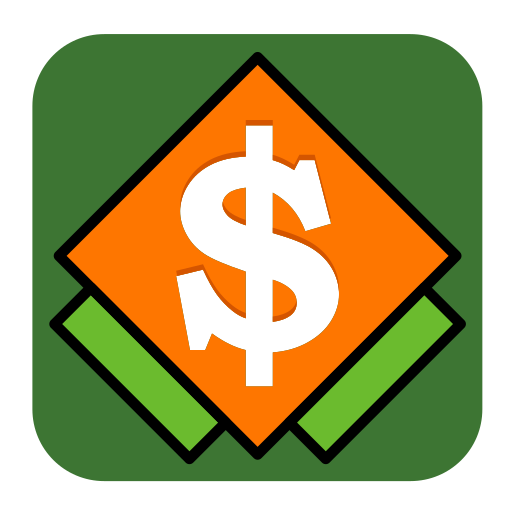
OpenTTD
The most active unofficial successor to r/OpenTTD!
See also lemmy.zip and feddit.de for other communities. The other Canadian branch on lemmy.ca is sadly no longer active.
Please do not ask where to get NewGRFs, they are easily obtainable via the in-game content downloader (a.k.a "BaNaNaS" or "the fruit store") or TT-Forums and certain authors have expressed they will not allow downloads of graphics that they no longer provide support for by penalty of copyright law. The other side of the coin is otherwise explained in our "rules" thread. Please read the rules thread before posting or do not post.
